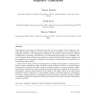255 search results - page 17 / 51 » Identifying Relations for Open Information Extraction |
BMCBI
2010
13 years 7 months ago
2010
Background: Primer and probe sequences are the main components of nucleic acid-based detection systems. Biologists use primers and probes for different tasks, some related to the ...
WISE
2002
Springer
14 years 6 days ago
2002
Springer
In recent years, several information retrieval methods using information about the Web-links are developed, such as HITS and Trawling. In order to analyze the Web-links dividing i...
ICSE
1998
IEEE-ACM
13 years 11 months ago
1998
IEEE-ACM
Decomposing complex software systems into conceptually independent subsystems is a significant software engineering activity which received considerable research attention. Most o...
AI
2005
Springer
13 years 7 months ago
2005
Springer
The KNOWITALL system aims to automate the tedious process of extracting large collections of facts (e.g., names of scientists or politicians) from the Web in an unsupervised, doma...
JSC
2010
13 years 2 months ago
2010
Both Sequence and Context Unification generalize the same problem: Word Unification. Besides that, Sequence Unification solves equations between unranked terms involving sequence ...

